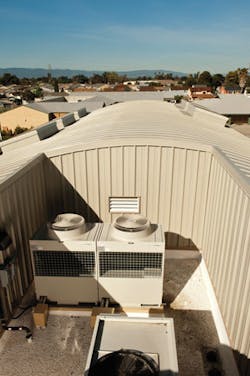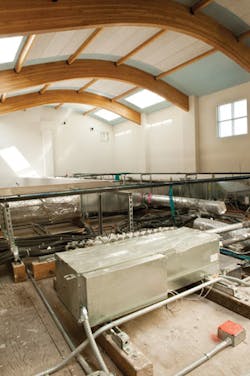VRF Zoning Helps School District Achieve Energy- and Cost-Saving Goals
In 2009, John D. Diffenderfer, AIA, LEED AP BD+C, O+M, a principal of Aedis Architecture & Planning in San Jose, Calif., received a phone call from the superintendent of the local Evergreen School District. George V. LeyVa Middle School was growing exponentially, and Evergreen wanted Aedis to design a separate administration building on the 23.4-acre campus.
“With a nationwide focus on energy savings, we wanted Evergreen to focus on sustainable building practices,” Diffenderfer said.
Working with Rancho Cordova, Calif.-based Capital Engineering Consultants Inc., Aedis set out to design an advanced energy-plus building.
Design Objective
The design team’s objective was for the 9,212-sq-ft administration building to be 41 percent more efficient than required by the California Energy Commission’s building energy-efficiency standards (Title 24) and capable of generating up to 8 percent surplus energy.
Energy modeling indicated the building should include a 39-kW photovoltaic (PV) array on the roof, a superinsulated building envelope, extensive daylight harvesting (no lights needed during the day), and superefficient windows. The PV array would deflect 70 percent of the sun’s heat back into the atmosphere, and the building envelope would keep 90 percent of the sun’s heat from the interior, greatly reducing the need for cooling.
HVAC Solution
With cooling and heating typically accounting for more than half of a building’s energy use, the design team knew the building should have a HVAC system that could operate efficiently at part-load conditions, which occur frequently in California’s mild climate.
“Steve Myers at Capital recommended the Mitsubishi Electric VRF (variable refrigerant flow) system for LeyVa,” Darryl Singleton, project manager for electrical-systems designer Integral Group of San Jose, said.
Myers took the team to see a nearby Mitsubishi Electric VRF zoning system in operation.
“The variable-speed compressors, simultaneous-cooling-and-heating capability, the energy efficiency of heat transfer, and intelligent controls are all very impressive engineering,” Singleton said.
The team presented its recommendations to Evergreen.
“Creative thinking is desperately required, and we should make this installation a de facto standard for all Evergreen schools,” Diffenderfer told administrators.
“We made a positive impression, and the district approved the Mitsubishi Electric VRF technology over all other feasible systems,” Myers said. “This system allows simultaneous cooling and heating, with multiple indoor units served from a single outdoor unit. This optimizes energy savings by allowing the system to match capacity requirements in each zone. The office space, which typically would be controlled by a packaged air-conditioning system, realizes superior zone control with the VRF zoning system.
“We liked the fact that the system is able to transfer heat from warm spaces, such as the computer room, and distribute that heat to other rooms with minimal power consumption,” Myers continued. “The Mitsubishi Electric system provides excellent comfort while keeping running costs to a minimum.”
According to Rob Smiley, director of operations for Evergreen School District, the system was easy to install and is easy to maintain.
“This system’s technology has contributed to saving us thousands of dollars this past year,” Smiley said. “And because of its exceptional zoning capabilities, there are no more zoning wars, and each office has its own temperature setting.”
Singleton added: “With its many advancements, I believe the greatest overall benefit is the quiet comfort the system delivers.”
Completed in time for the 2011-2012 school year, the administration building produces 108 percent of its own energy and saves the school district more than $9,000 a year in energy costs.
For Design Solutions author guidelines, call Scott Arnold, executive editor, at 216-931-9980, or write to him at [email protected].



